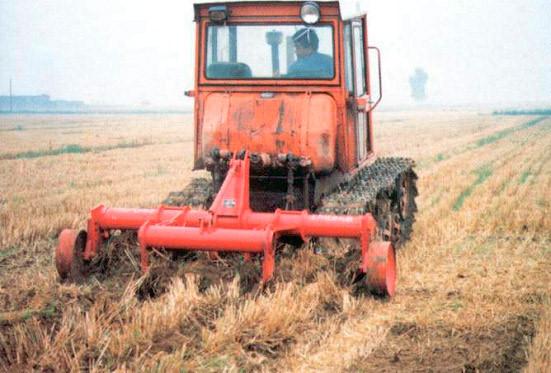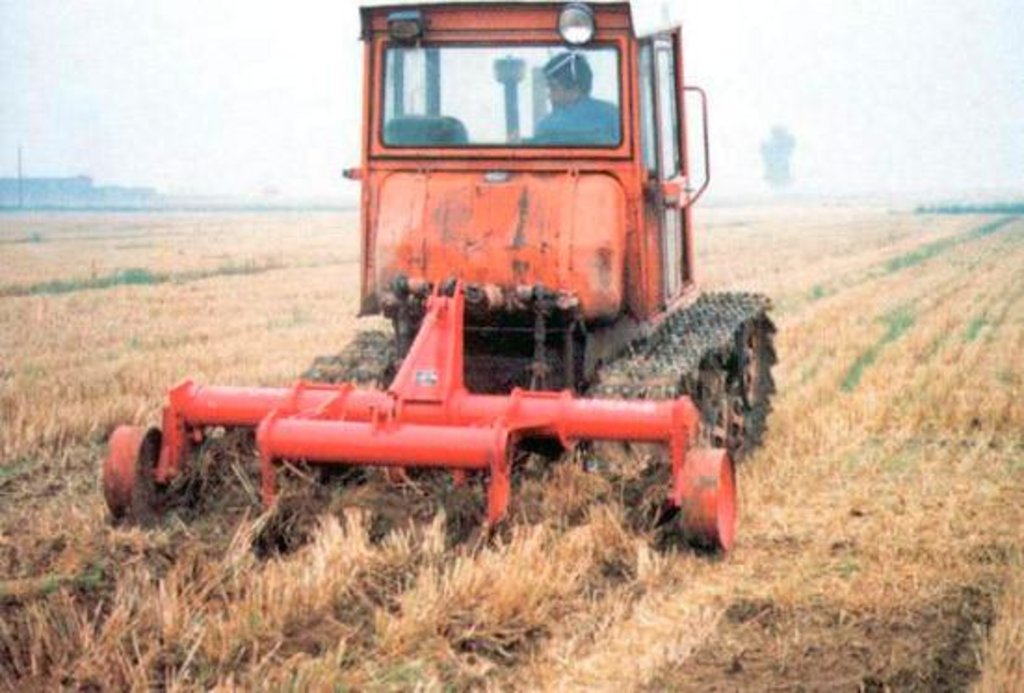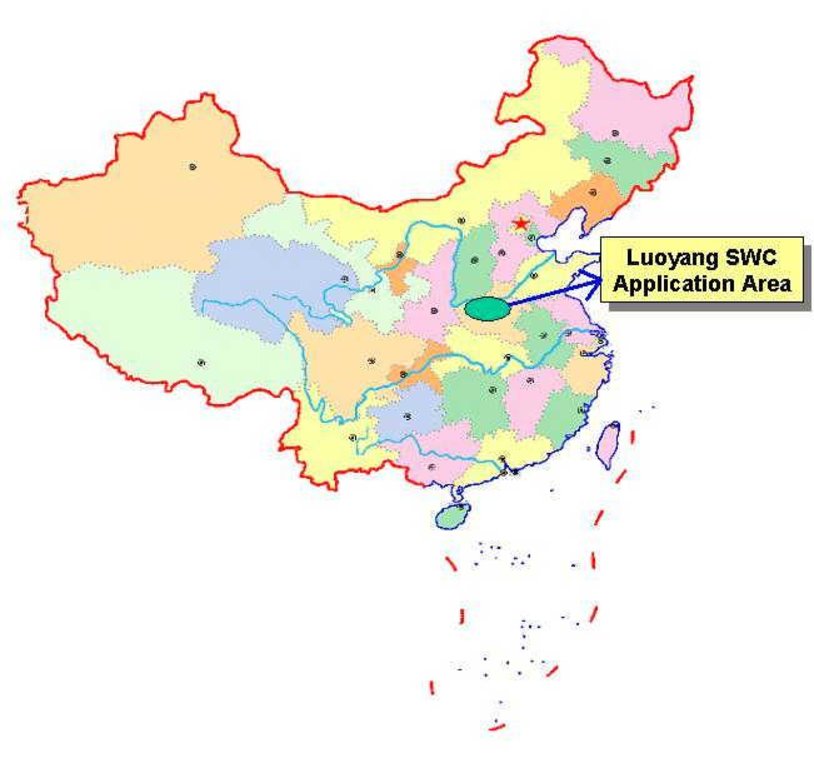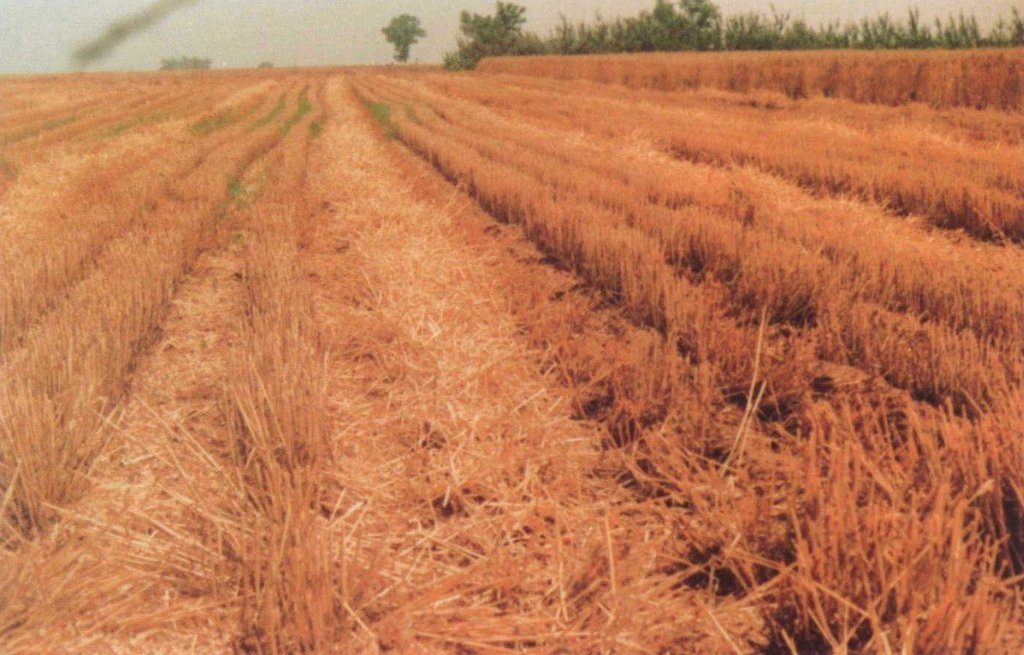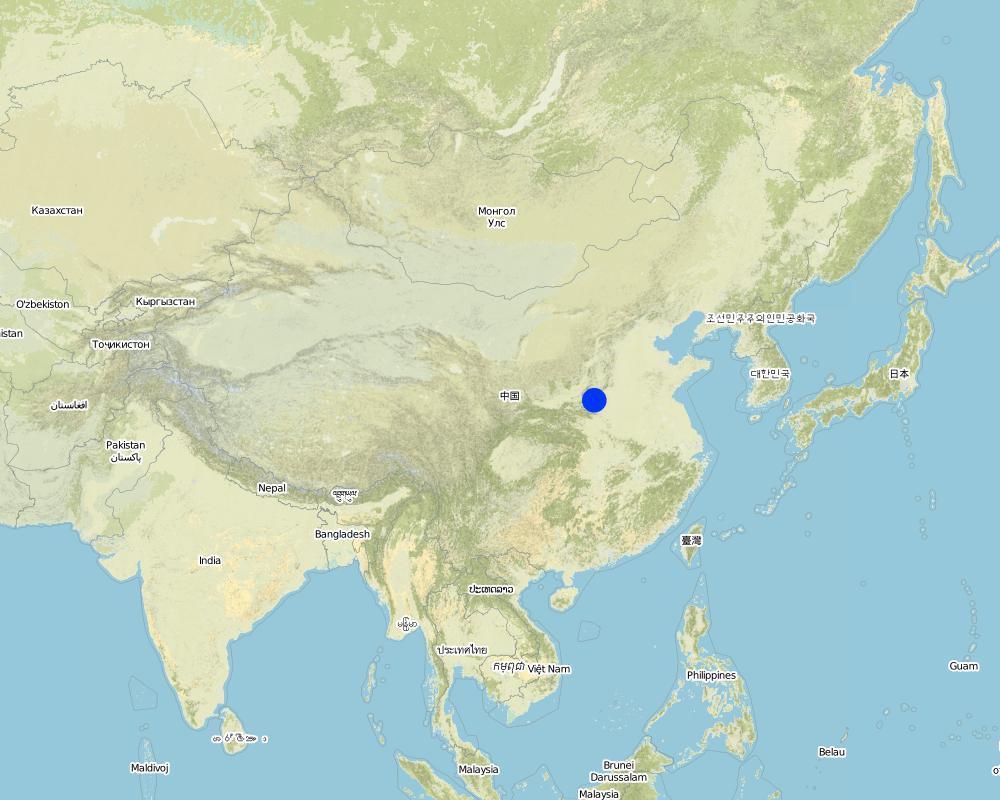Subsoiling [Chine]
- Création :
- Mise à jour :
- Compilateur : Zhanguo Bai
- Rédacteur : –
- Examinateur : Laura Ebneter
approaches_2401 - Chine
Voir les sections
Développer tout Réduire tout1. Informations générales
1.2 Coordonnées des personnes-ressources et des institutions impliquées dans l'évaluation et la documentation de l'Approche
Nom du ou des institutions qui ont facilité la documentation/ l'évaluation de l'Approche (si pertinent)
Institute of Agricultural Resources and Regional Planning of Chinese Academy of Agricultural Sciences (CAAS) - Chine1.3 Conditions relatives à l'utilisation par WOCAT des données documentées
Le compilateur et la(les) personne(s) ressource(s) acceptent les conditions relatives à l'utilisation par WOCAT des données documentées:
Oui
1.4 Références au(x) questionnaire(s) sur les Technologies de GDT
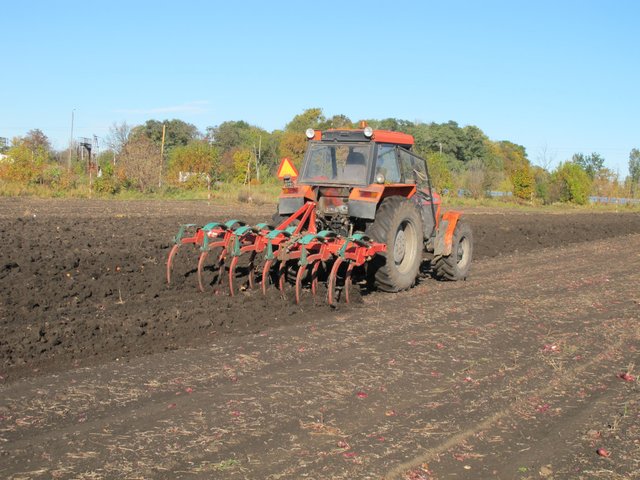
Subsoiling [Pologne]
Subsoiling is defined as tillage below a depth of about 35-40 cm which doesn't invert the soil. It breaks up compacted layers to improve rooting and infiltration. Subsoiling is not needed on light soils, because these are rarely at risk of compaction.
- Compilateur : Tymoteusz Bolewski
2. Description de l'Approche de GDT
2.1 Courte description de l'Approche
Subsoiling with mulching is one of the conservative tillage using subsoiling plough to loose subsoils with surface soil undisturbed.
2.2 Description détaillée de l'Approche
Description détaillée de l'Approche:
Sustainable agriculture in the dry and semidry region in the North China, especially o the slope farmland is searching always based on the ecological balance. Conservative tillage such as subsoiling, zero and reduced tillage are important to keep soil fertility. Mulching is also a way to improve the soil organic matter. So subsoiling with mulching is an approach to do this. Subsoiling using subsoiling plough is to loose subsoils let all rainfall in the soils and avoid runoff occur.
2.3 Photos de l'approche
2.5 Pays/ région/ lieux où l'Approche a été appliquée
Pays:
Chine
Région/ Etat/ Province:
Henan
Map
×2.6 Dates de début et de fin de l'Approche
Indiquez l'année de démarrage:
1995
Date (année) de fin de l'Approche (si l'Approche n'est plus appliquée):
2003
2.7 Type d'Approche
- fondé sur un projet/ programme
2.8 Principaux objectifs de l'Approche
The main objectives of the approach is to change the traditional multi-till farming to conservation tillage for sustainable agricultural development.
The SLM Approach addressed the following problems: Traditional multi-tillage farming system with little return of organic matters to soils results in soil fertility decline and nutrient loss as well as yield decrease. This approach is designed to change the traditional pattern to conservation tillage.
2.9 Conditions favorisant ou entravant la mise en œuvre de la(des) Technologie(s) appliquée(s) sous l'Approche
disponibilité/ accès aux ressources et services financiers
- entrave
Lack of fund to buy till machines
Treatment through the SLM Approach: subsidy
cadre juridique (régime foncier, droits d'utilisation des terres et de l'eau)
- favorise
The existing land ownership, land use rights / water rights helped a little the approach implementation: Because land ownership belongs to state.
3. Participation et rôles des parties prenantes impliquées dans l'Approche
3.1 Parties prenantes impliquées dans l'Approche et rôles
- exploitants locaux des terres / communautés locales
work equally divided between men and women (Because of expensive input for buying tools, usually several households can jointly buy one set, so they generally work as a group)
- gouvernement national (planificateurs, décideurs)
3.2 Participation des exploitants locaux des terres/ communautés locales aux différentes phases de l'Approche
| Participation des exploitants locaux des terres/ communautés locales | Spécifiez qui était impliqué et décrivez les activités | |
|---|---|---|
| initiation/ motivation | passive | interviews/questionnaires; Generally local and/or village committee call land users who involved in the SWC project together and illustrate the purpose and obligation. |
| planification | interactive | rapid/participatory rural appraisal |
| mise en œuvre | interactive | responsibility for minor steps; Each step and procedures are guided and checked for implementation. |
| suivi/ évaluation | interactive | measurements/observations; Mainly done by the researchers and local government staffs not by local land users. |
| Research | passive | on-station; The effect and impacts of the SWC technology on the soil and environment are investigated and studied on experimental station and on farm. |
3.4 Prises de décision pour la sélection de la Technologie/ des Technologies
Indiquez qui a décidé de la sélection de la Technologie/ des Technologies à mettre en œuvre:
- principalement les spécialistes de la GDT, après consultation des exploitants des terres
Expliquez:
Decisions on the choice of SLM Technology were made directive (top-down).
Decisions on the method of implementing the SLM Technology were made by mainly by SLM specialists with consultation of land users.
4. Soutien technique, renforcement des capacités et gestion des connaissances
4.1 Renforcement des capacités/ formation
Une formation a-t-elle été dispensée aux exploitants des terres/ autres parties prenantes?
Oui
Spécifiez qui a été formé:
- exploitants des terres
- SWC specialists, extensionists/trainers
Formats de la formation:
- entre agriculteurs (d'exploitants à exploitants)
- zones de démonstration
- réunions publiques
- cours
Thèmes abordés:
Teaching them how to operate tractors/tillage with residuals and soil & water conservation knowledge, etc.
4.2 Service de conseils
Les exploitants des terres ont-ils accès à un service de conseils?
Oui
Spécifiez si le service de conseils est fourni:
- dans les champs des exploitants?
Décrivez/ commentez:
Name of method used for advisory service: In situ demonstration and training; Key elements: Demonstration, Introduction, Training; 1) Mainly: projects own extension structure and agents Partly: partly: government's existing extension system 2) Mainly: projects own extension structure and agents Partly: partly: government's existing extension system; Extension staff: mainly government employees 3) Target groups for extension: land users; Activities: Demonstration, training
Advisory service is quite adequate to ensure the continuation of land conservation activities; There is a nation-wide top-down agricultural technology extension service system which can support the activity.
4.3 Renforcement des institutions (développement organisationnel)
Des institutions ont elles été mises en place ou renforcées par le biais de l'Approche?
- oui, beaucoup
Spécifiez à quel(s) niveau(x), ces institutions ont été renforcées ou mises en place:
- local
Précisez le type de soutien:
- financier
- renforcement des capacités/ formation
- équipement
4.4 Suivi et évaluation
Le suivi et l'évaluation font ils partie de l'Approche? :
Oui
Commentaires:
bio-physical aspects were regular monitored through observations
economic / production aspects were regular monitored through measurements
area treated aspects were regular monitored through observations
land users involved aspects were ad hoc monitored through measurements
management of Approach aspects were ad hoc monitored through observations
There were few changes in the Approach as a result of monitoring and evaluation
4.5 Recherche
La recherche a-t-elle fait partie intégrante de l’Approche?
Oui
Spécifiez les thèmes:
- écologie
- technologie
Donnez plus de détails et indiquez qui a mené ces recherches:
The successful results of the SWC study obtained by the SWC approach are widely applied to the control of the dust devil, and ecological recover. Research was carried out both on station and on-farm
5. Financement et soutien matériel externe
5.1 Budget annuel de la composante GDT de l'Approche
Si le budget annuel précis n'est pas connu, indiquez une fourchette:
- 100 000-1 000 000
Commentez (par ex. principales sources de financement/ principaux bailleurs de fonds):
Approach costs were met by the following donors: government (national - Central government): 60.0%; international (NGO): 5.0%; local community / land user(s) (Luoyang): 30.0%; other (-): 5.0%
5.3 Subventions pour des intrants spécifiques (incluant la main d'œuvre)
- équipement
| Spécifiez les intrants subventionnés | Dans quelle mesure | Spécifiez les subventions |
|---|---|---|
| machines | en partie financé | |
- intrants agricoles
| Spécifiez les intrants subventionnés | Dans quelle mesure | Spécifiez les subventions |
|---|---|---|
| fertilisants | en partie financé | |
- infrastructures
| Spécifiez les intrants subventionnés | Dans quelle mesure | Spécifiez les subventions |
|---|---|---|
| community infrastructure | en partie financé | |
Si la main d'œuvre fournie par les exploitants des terres était un intrant substantiel, elle était:
- volontaire
Commentaires:
The labour war voluntary, paid in cash and rewarded with other material support.
In the past(before 1980's), SWC activities are mainly done by community members through obligation. Nowadays under the conditions of economic market, people unwill to do this voluntary, they concern return of their input for SWC.
5.4 Crédits
Des crédits ont-ils été alloués à travers l'Approche pour les activités de GDT?
Oui
Spécifiez les conditions (taux d'intérêts, remboursements, etc.):
Interest rate charged: 2.3%; repayment conditions: After 2 to 5 years when SWC produces benefits, loaner should repay.
Interest was lower than market rate.
6. Analyses d'impact et conclusions
6.1 Impacts de l'Approche
Est-ce que l'Approche a aidé les exploitants des terres à mettre en œuvre et entretenir les Technologies de GDT?
- Non
- Oui, un peu
- Oui, modérément
- Oui, beaucoup
Soil & water loss reduced much and soil fertility is improved greatly with increase in yield
Est-ce que l'Approche a amélioré les questions foncières et des droits d'utilisation qui entravent la mise en œuvre des Technologies?
- Non
- Oui, un peu
- Oui, modérément
- Oui, beaucoup
Subdivision and lease of the land would hinder SWC implementation. The problem is likely to be overcome in the near future. Farmers worry that their land would transfer to others
Did other land users / projects adopt the Approach?
- Non
- Oui, un peu
- Oui, modérément
- Oui, beaucoup
6.3 Durabilité des activités de l'Approche
Les exploitants des terres peuvent-ils poursuivre ce qui a été mis en œuvre par le biais de l'Approche (sans soutien extérieur)?
- oui
6.4 Points forts/ avantages de l'Approche
| Points forts/ avantages/ possibilités du point de vue de l'exploitant des terres |
|---|
| Easy to operate in the field (How to sustain/ enhance this strength: better subsoiling plough quality) |
| Points forts/ avantages/ possibilités du point de vue du compilateur ou d'une autre personne ressource clé |
|---|
| Increase in soil moisture and decrease runoff occur (How to sustain/ enhance this strength: Trying best to maintain soil moisture.) |
| Increase in soil fertility (How to sustain/ enhance this strength: Leaving as higher straw as possible when harvest) |
| Raising yield and farmer's income (How to sustain/ enhance this strength: Demonstration and Widely extension should be enhanced.) |
| Yield increased (How to sustain/ enhance this strength: Planting much more cash crops if possible) |
6.5 Faiblesses/ inconvénients de l'Approche et moyens de les surmonter
| Faiblesses/ inconvénients/ risques du point de vue de l’exploitant des terres | Comment peuvent-ils être surmontés? |
|---|---|
| Too expensive input at the beginning of the SWC implementation | It is needed to financial aid for buying tillage plough and tractor |
| Faiblesses/ inconvénients/ risques du point de vue du compilateur ou d'une autre personne ressource clé | Comment peuvent-ils être surmontés? |
|---|---|
| Quality of subsoiling machine is poor | Improving the tillage tool quality. |
7. Références et liens
7.1 Méthodes/ sources d'information
- visites de terrain, enquêtes sur le terrain
- interviews/entretiens avec les exploitants des terres
7.2 Références des publications disponibles
Titre, auteur, année, ISBN:
Report of ninth-Five plan project on Dryland Farming, 2002
Disponible à partir d'où? Coût?
internal materials
Titre, auteur, année, ISBN:
Introduction of Luoayng physicography, 2000
Disponible à partir d'où? Coût?
unpublished reference
Titre, auteur, année, ISBN:
No-till farming for sustainable rural development, 2002
Disponible à partir d'où? Coût?
World Bank
Titre, auteur, année, ISBN:
A road map from conventional to no-till farming, 2002
Disponible à partir d'où? Coût?
World Bank
Titre, auteur, année, ISBN:
Conservation agriculture, 2001
Disponible à partir d'où? Coût?
FAO
Liens et modules
Développer tout Réduire toutLiens

Subsoiling [Pologne]
Subsoiling is defined as tillage below a depth of about 35-40 cm which doesn't invert the soil. It breaks up compacted layers to improve rooting and infiltration. Subsoiling is not needed on light soils, because these are rarely at risk of compaction.
- Compilateur : Tymoteusz Bolewski
Modules
Aucun module trouvé


